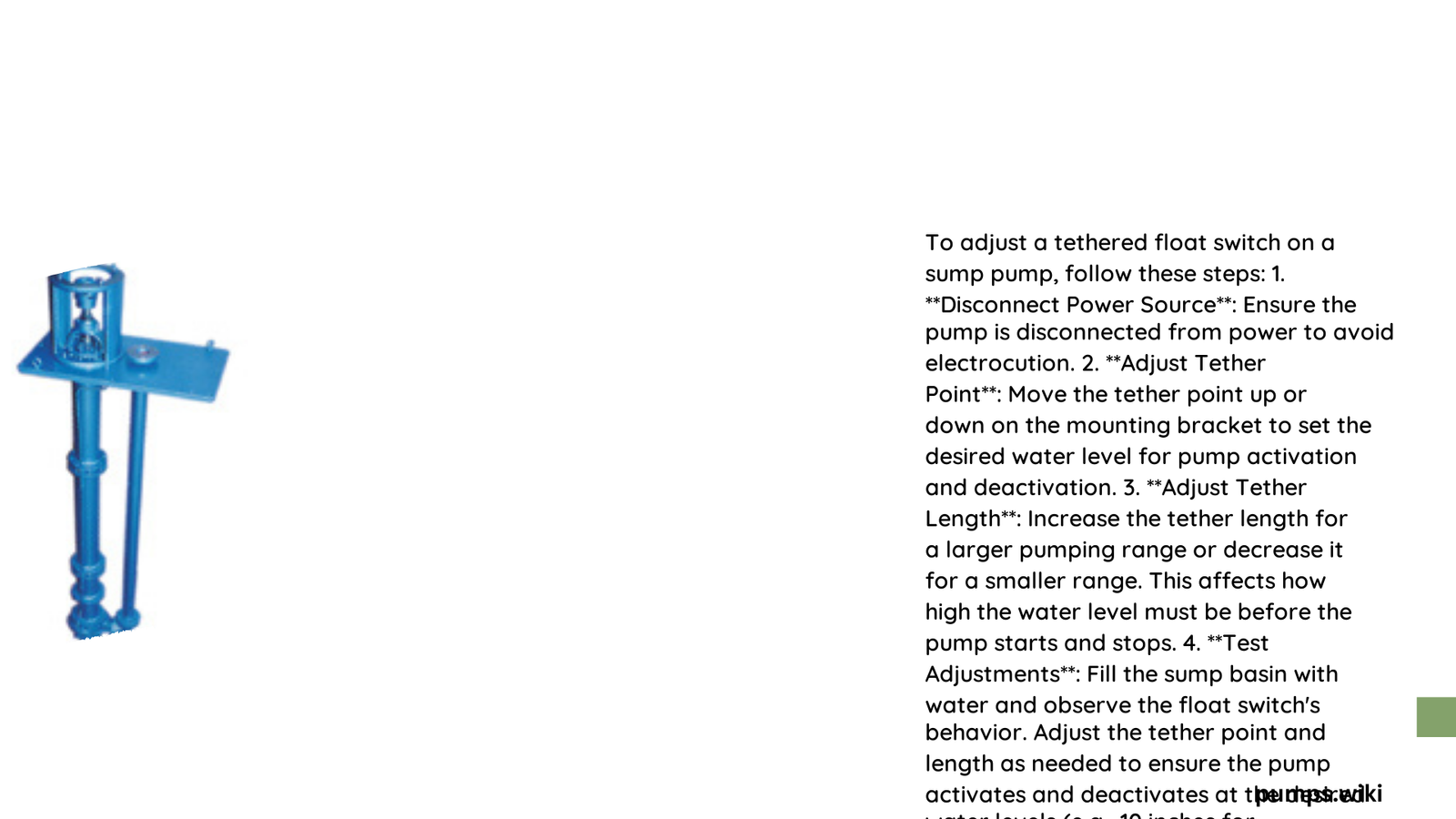Adjusting a tethered float switch on a sump pump is crucial for maintaining proper water levels and preventing basement flooding. This process involves setting the correct tether point and length to ensure the pump activates and deactivates at appropriate water levels. Proper adjustment can significantly improve the efficiency and longevity of your sump pump system, reducing the risk of water damage and pump failure.
What is a Tethered Float Switch?
A tethered float switch is a mechanism attached to a sump pump that controls its operation based on water levels. It consists of a buoyant float connected to a switch via a flexible cord or tether. As water levels rise, the float lifts, activating the pump. When water levels drop, the float lowers, turning off the pump.
Why is Proper Adjustment Important?

Correct adjustment of the tethered float switch is essential for:
- Preventing premature pump activation
- Avoiding pump burnout from running dry
- Ensuring efficient water removal
- Extending the lifespan of the sump pump
What Tools are Needed for Adjustment?
To adjust your tethered float switch, you’ll need:
- Adjustable wrench or pliers
- Zip ties or clips
- Marker or tape
- Bucket of water
How to Adjust the Tethered Float Switch?
Follow these steps to adjust your tethered float switch:
- Disconnect the power source
- Mount the tether point
- Position the tether point
- Adjust the tether length
- Conduct initial testing
- Fine-tune adjustments
- Perform final testing
Step 1: How to Safely Disconnect the Power?
Before making any adjustments:
- Locate the power source of your sump pump
- Unplug the pump from the electrical outlet
- If hardwired, turn off the circuit breaker supplying power to the pump
Step 2: How to Mount the Tether Point?
To mount the tether point:
- Identify a suitable mounting location (sump pit wall or cover)
- If using a mounting bracket, secure it firmly to the chosen location
- For systems without a bracket, use a clamp or zip tie to attach the tether point to a fixed structure within the tank
Step 3: How to Position the Tether Point?
Proper positioning of the tether point is crucial:
- Estimate the desired activation level for your pump
- Mark the activation and deactivation levels inside the sump basin
- Adjust the tether point height to align with these marks
Step 4: How to Adjust the Tether Length?
To adjust the tether length:
- Determine the required range of motion for your float
- Increase tether length for a larger range of water levels
- Decrease tether length for a smaller range
- Adjust by letting out more cord or shortening it between the tether point and float
Step 5: How to Conduct Initial Testing?
For initial testing:
- Fill the sump basin with water
- Observe when the pump activates and deactivates
- Note the water levels at these points
- If activation occurs too early or late, adjust the tether point accordingly
Step 6: How to Fine-Tune Adjustments?
Fine-tuning involves:
- Lengthening the tether if the pump starts too early or late
- Shortening the tether to reduce the range of motion
- Manually lifting and lowering the float to verify correct activation points
Step 7: How to Perform Final Testing?
For final testing:
- Reattach the power source
- Simulate rain by adding water to the basin
- Ensure the pump activates at the desired level
- Verify that the pump runs until the basin is nearly empty
- Check that enough water remains to cover the pump’s inlet screen
What are Common Troubleshooting Issues?
| Issue | Cause | Solution |
|---|---|---|
| Float sticking | Debris, improper tether length, incorrect positioning | Clean sump pit, adjust tether, reposition float |
| Pump not activating | Faulty switch, incorrect tether adjustment | Test switch functionality, readjust tether |
| Continuous pump running | Float switch stuck in ‘on’ position | Check for obstructions, adjust tether length |
When Should You Replace the Float Switch?
Consider replacement if you observe:
- Continuous running of the pump
- Failure to activate or deactivate at correct water levels
- Visible damage to the float or tether
How to Replace a Tethered Float Switch?
- Disconnect the power source
- Remove the old float switch
- Install the new float switch
- Adjust the tether point and length
- Test the new installation
What are Best Practices for Float Switch Maintenance?
To ensure optimal performance:
- Regularly clean the sump pit
- Test the float switch monthly
- Inspect for signs of wear or damage
- Adjust the tether as needed based on seasonal changes
By following these guidelines, you can effectively adjust and maintain your tethered float switch, ensuring your sump pump operates efficiently and reliably.
